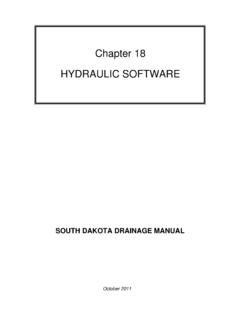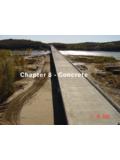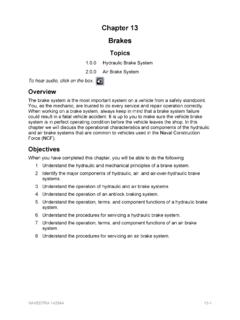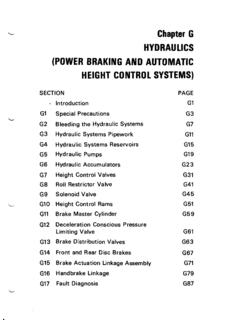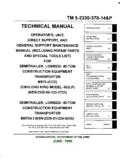Transcription of CHAPTER 5 HORIZONTAL ALIGNMENT
1 5-1 CHAPTER 5 HORIZONTAL ALIGNMENT Introduction 5-2 Factors Influencing the Selection of HORIZONTAL ALIGNMENT 5-2 General Criteria 5-3 Sight Distance 5-5 Figure 5-1 Sight Distance Measurements for HORIZONTAL Curves HORIZONTAL & Vertical ALIGNMENT Coordination 5-9 Striping No-Passing Zones 5-10 Intersecting Roads 5-10 Utilities 5-11 Transition (Spiral Curves)
2 5-11 Circular Curves 5-11 Figure 5-2 Circular Curves Superelevation 5-13 Figure 5-3 Superelevation Transitions Figure 5-4 Sample Calculation Figure 5-5 Superelevation Transition for 2 Lane Highway Table 5-1 Rural Low Speed Table 5-2 Urban Low Speed Table 5-3 High Speed Figure 5-6 Superelevation Transition for Divided Highways Table 5-4 Maximum Relative Gradient Traffic Diversion ALIGNMENT 5-30 5-2 INTRODUCTION HORIZONTAL and vertical alignments establish the general character of a rural highway, perhaps more than any other design consideration.
3 The configuration of line and grade affects safe operating speeds, sight distances, and opportunities for passing and highway capacity. Decisions on ALIGNMENT have a significant impact on construction costs. The continuous line of a highway is formed longitudinally by its " ALIGNMENT " in the HORIZONTAL and vertical planes. In combination with the cross-sectional element, the highway then -- in three dimensions -- becomes functional and operative. The elements for purposes of geometric design are first treated separately and finally combined and coordinated to form the whole facility.
4 The assembly of these units into a continuous whole establishes the ALIGNMENT of the road. The components of the HORIZONTAL ALIGNMENT include tangents (segments of straight lines), circular curves and, in some cases, spiral transition curves. The manner in which these components are assembled into a HORIZONTAL ALIGNMENT will significantly affect the safety, operational efficiency, and aesthetics of the highway. FACTORS INFLUENCING THE SELECTION OF HORIZONTAL ALIGNMENT Some of the factors that influence the location and configuration of the HORIZONTAL ALIGNMENT include: 1.
5 Physical controls - topography, watercourses, geophysical conditions, land use, and man-made features. 2. Environmental considerations - affect on adjacent land use, community impacts, ecologically sensitive areas. 3. Economics - construction costs, right-of-way costs, utility impacts, operating and maintenance costs. 4. Safety - sight distance, consistency of ALIGNMENT , human factor considerations. 5. Highway classification and design policies - functional classification, level of service, design speed, design standards. Although the designer must attempt to optimize the HORIZONTAL ALIGNMENT with respect to these factors, the ALIGNMENT cannot be finalized until it has been compared and coordinated with the vertical and cross-sectional features of the highway.
6 5-3 GENERAL CRITERIA Design speed is the principal factor controlling the design of HORIZONTAL ALIGNMENT . Several geometric standards related to design speed are very specific. Other criteria cannot be defined as specifically and require that judgments be made by designers in consideration of local conditions. Guidelines for some of these decisions are outlined below. Additional, general discussion on Design Speed can be found in CHAPTER 2 of the current AASHTO publication A Policy on Geometric Design of Highways and Streets. In general, above-minimum design criteria for specific design elements should be used, where practical, particularly on high-speed facilities.
7 In contrast, the designer is cautioned that on lower speed facilities, use of above-minimum design criteria may encourage travel at speeds higher than the design speed. Consistency ALIGNMENT should be consistent and as directional as possible. A smooth flowing ALIGNMENT is desirable on a rural arterial. Changes in ALIGNMENT , both HORIZONTAL and vertical, should be sufficiently gradual to avoid surprising the driver. Frequent changes in ALIGNMENT with many short curves should be avoided except in cases of very low design speed and low traffic volume in rough terrain.
8 Sharp and / or short curves should not be introduced at the ends of long tangents. Sudden changes from areas of easy curvature to sharp curvature should be avoided. Where sharp curvature must be introduced, it should be gradually approached by successively sharper curves from the generally easy curvature. Length of Curves Avoid the use of the maximum permissible degree of curvature except where absolutely necessary. Generally, curves should be as flat as practicable for the conditions. On the other hand, avoid the use of excessively long, flat curves where there is need to provide considerable passing opportunities.
9 Drivers are reluctant to pass on a curve, even though the sight distance may be adequate. It may be better to use a shorter curve, thus lengthening the adjacent tangent section and increasing the passing opportunity. A HORIZONTAL curve is not required for deflection angles of 15 minutes or less. For small deflection angles greater than 15 minutes, curves should be long enough to avoid the appearance of a "kink". Curves should be at least 500 feet (150 m) long for a deflection angle of 5 degrees, and the minimum length should be increased 100 feet (30 m) for each 1 degree decrease in deflection angle.
10 (Note In the superelevation tables, the minimum curve radii for each design speed without superelevation is listed. This is a separate, different criteria from that noted above.) 5-4 The minimum length of HORIZONTAL curves on main highways should be about (L = 15 x Vd) in (ft) or (L = 3 x Vd) in (m). (Vd = Design Speed in mph or kph & L = Length of Curve in ft or m.) On high-speed controlled access highways, a desirable minimum length of curve would be about (L = 30 x Vd) in (ft) or (L = 6 x Vd) in (m). Adjacent Curves Care should be used in the design of compound curves.


